The iPhone SE Review
by Brandon Chester on May 16, 2016 8:00 AM EST- Posted in
- Smartphones
- Apple
- Mobile
- iPhone
- iPhone SE
System Performance
With the iPhone SE I've decided to make the transition to our 2016 benchmark suite. We've been including some of these for a little while now, and some tests from our previous suite are still around. There is one test omitted, which is Basemark ES / Basemark Metal, which we'll be deploying once we have all the data from this year's flagship Android smartphones. Comparisons to those Android phones will also have to wait until their respective reviews, and for now I can only really compare the iPhone SE to Apple's other iPhones along with 2015's flagship Android devices.
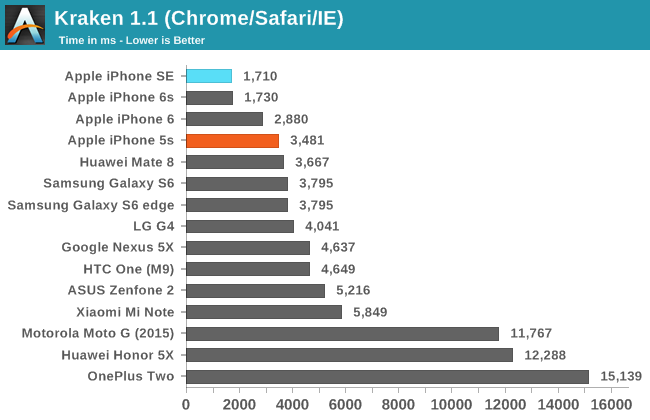
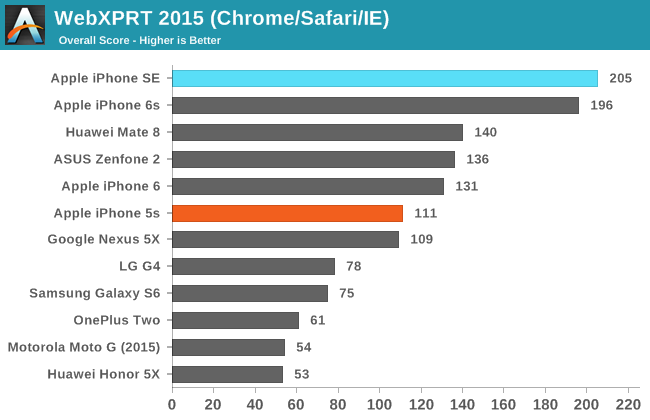
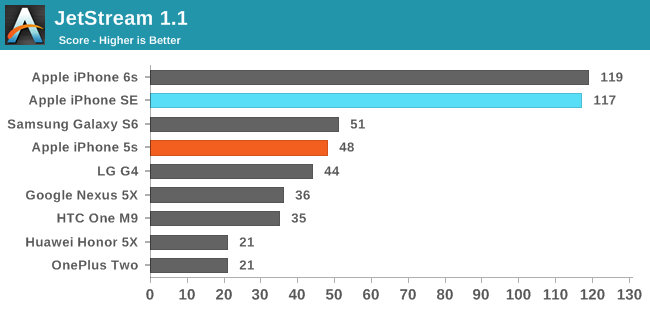
At this point I think we're ready to move to our 2016 web browser benchmarks. Octane is now retired, as there's a large degree of overlap between it and JetStream, with JetStream using a more sensible methodology with measurements for tests like the mandreel-latency test. Kraken, Octane, and Jetstream all have some overlap, but Kraken and JetStream are different enough to make it worth keeping Kraken on. Finally there's WebXPRT 2015, which we already introduced as a replacement for WebXPRT 2013 some time ago.
As expected, the iPhone SE matches the iPhone 6s in our JavaScript tests. The improvement over the iPhone 5s is significant, with roughly double the performance in all cases. This is right in line with Apple's 2x performance claim, and it's important to note that these are updated iPhone 5s figures run on iOS 9 to ensure that it also benefits from the improvements made to Apple's Nitro JavaScript engine since it launched in 2013.
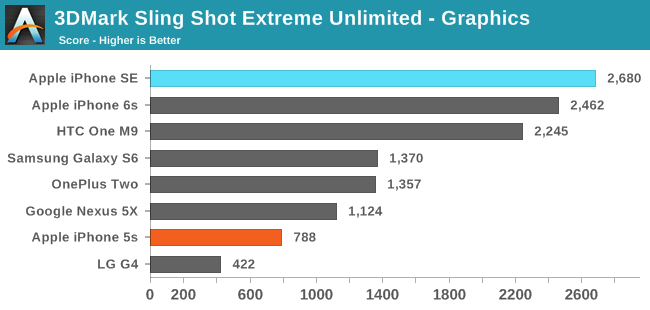
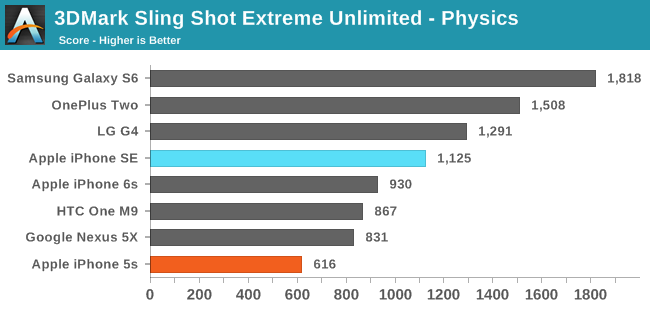
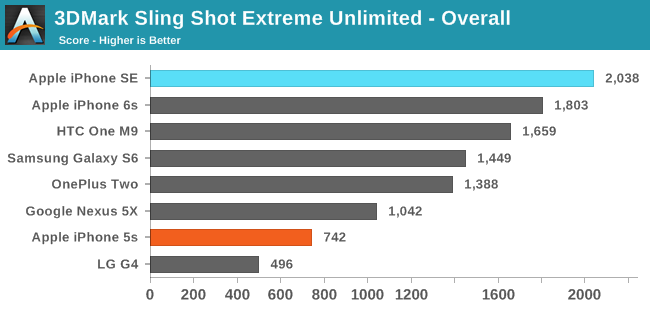
We originally planned to use 3DMark Sling Shot Unlimited, which is an OpenGL ES 3.0 test that runs off screen 1920 x 1080 tests to produce results that are useful for comparing devices and SoCs. However, in the interest of test longevity we have moved to the even newer Sling Shot Extreme test, which uses OpenGL ES 3.1 on Android and Metal on iOS, with a Vulkan version coming to Android in the future. The tests in Sling Shot Extreme render off screen at 2560 x 1440, so it should be a good target for GPU performance well into the future.
In this test the iPhone SE performs well. I experienced a strange situation where the iPhone 6s would consistently score lower than the SE, and I'm not sure if this is due to driver differences or some other problem, but in any case the SE and the 6s both end up at the top of the chart, and the final score is nearly three times higher than that of the iPhone 5s. I'm still waiting on final reviews for this year's Android flagships, so comparisons to Snapdragon 820 and Exynos 8890 will have to wait a bit longer.
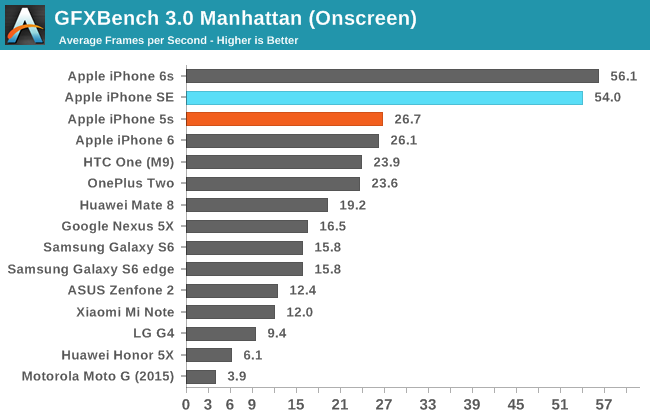
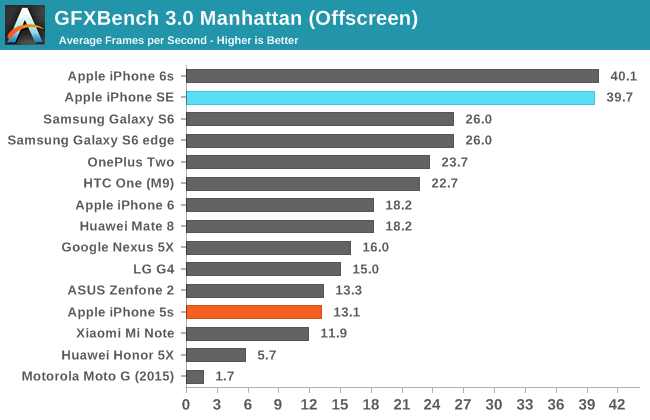
With T-Rex HD being such an old test, I've decided to retire it except perhaps for reviews of devices with relatively slow SoCs. That leaves GFXBench 3.0 Manhattan, and hopefully GFXBench 4.0 in the near future. In Manhattan the iPhone SE performs exceptionally well, achieving a frame rate that is ever so slightly more than three times that of the iPhone 5s. While there's obviously a degree of variance, I think this shows that Apple's 3x GPU performance claim is not an exaggeration, and on such a tiny display with a relatively low resolution you can render a scene like Manhattan at native resolution and almost achieve 60fps.
NAND Performance
With the first generation of the MacBook, Apple introduced their own PCI-E SSD controller with support for NVMe. At the launch of the iPhone 6s and iPad Pro, they noted that both devices had significantly improved storage performance. During the course of our review we discovered that Apple had essentially brought some version of their controller down to their mobile devices, and as a result they led the rest of the mobile market by a large margin when it came to overall storage performance.
With the iPhone SE, Apple uses the same controller as they do in the iPhone 6s and iPad Pro. Since this iPhone is a 64GB unit, we can take a look at the potential impact of a smaller SSD that may not be able to utilize parallelism to achieve the same performance as its 128GB and 256GB counterparts in Apple's other devices. To analyze the storage performance of the iPhone SE I've used StorageBench, a NAND benchmark developed by Eric Patno which is comparable to our AndroBench 3.6 test on Android.

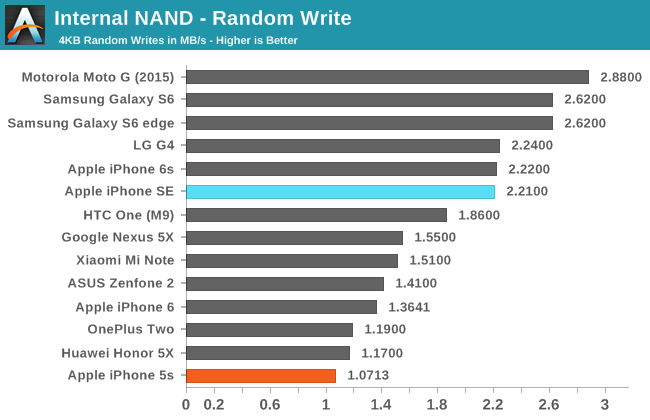
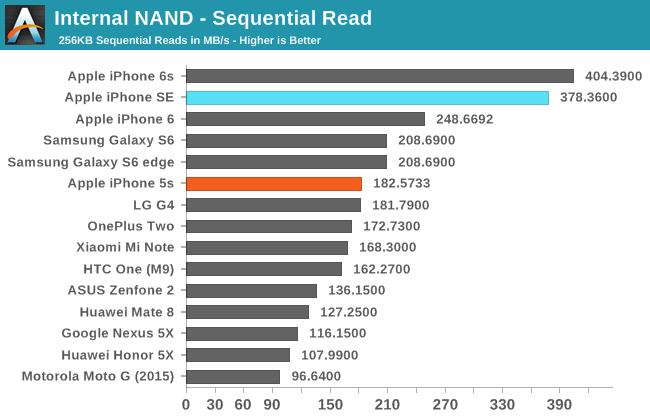
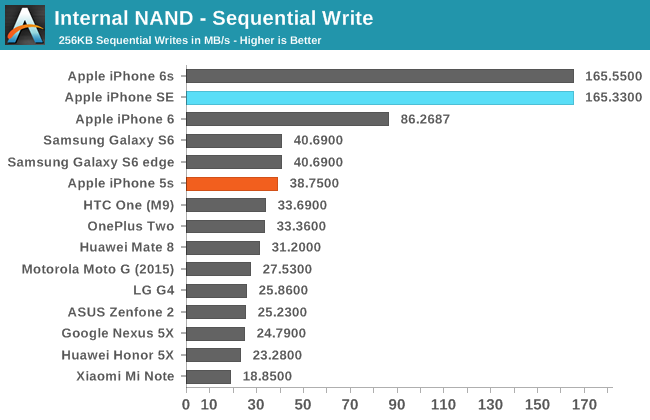
Despite the fact that the storage capacity is half that of our iPhone 6s review unit, the iPhone SE performs essentially just as well. Random reads actually end up being faster, while random writes are nearly identical. Sequential reads trail the 6s by a bit, but sequential writes end up being identical much like random writes. The differences are enough to attribute to testing variance, and it's probably safe to say that the storage performance on the 64GB iPhone SE is identical to that of the 64GB and 128GB models of the iPhone 6s.










138 Comments
View All Comments
msork - Monday, May 16, 2016 - link
I bought one. I love the 4" phone.zeeBomb - Monday, May 16, 2016 - link
Dang this review took ages, but nice.Brandon Chester - Monday, May 16, 2016 - link
I have to apologize for the time it took, it's probably two weeks longer than it should have taken. I was in the middle of moving to a new city and also starting a new job during the course of the review which is what caused the delays.zeeBomb - Tuesday, May 17, 2016 - link
Oh! No worries then. When life happens, all you can do is just adapt.Neonomide - Monday, May 16, 2016 - link
Bundling a 10-15W charger with the phone would be stupid, as the battery cycles would suffer. Charging a phone battery too fast takes a toll on battery life in the long run and that's the main reason Apple does not do it.TheinsanegamerN - Monday, May 16, 2016 - link
Doesnt seem to have affected my coworkers iphone 6 at all, despite him using a ipad charger.Apple's charging circuit should only let in as much amperage as the battery can take without suffering damage.
GC2:CS - Tuesday, May 17, 2016 - link
iPhone 6 can take up to 10W I think, not only for charging but also for powering itself. It charges a good few minutes faster than with 5W, the more you load the phone the bigger the difference.Plus iPhones take quite a bit more power for just charging.
What I find interesting that it can use up 5W to charge it's 6,21Wh battery much faster than 5S. That's deffinitelly in part that iPhone devices prior to 6 took some bit less less than 5W to charge, but still the difference is almost faulty looking to me.
Then we got MacBook and iPad Pro charging in 2 hours at 29W, 9,7" iPad Pro supposedly charging super quick (~3 hours) even with it's included (pooor poor 10W) charger, great for a tablet, not ultra quick, but there is Apple smart battery case which can take some super quick charging times when conected to 10/12W iPad adapters.
The question is, what will happen when you connect this phone to a 12W charger ? Can it take more power in like iPhone 6 does ? Does it have that mysterious battery tech like SBC , which gets soaked quickly ?
Not to say Apple wants to unexpectedly come up with fast charging, I think they are going after it for some time, but what does that mean for the next iPhone... Ultra iCharge confirmed ?
thestinkinggenius - Monday, May 16, 2016 - link
I own this phone and two things that drive me nuts are:1: Bluetooth calls sound like crap - this is a known issues and is being fixed in the 9.3.2 beta
2: Cell reception is sub par - I work in a basement office and regularly get disconnected in the middle of a call (I also use a Nexus 5x and never get disconnected). If I turn on Wifi calling it still happens.
sfwineguy - Monday, May 16, 2016 - link
I'm very glad to read the details of this comment (mainly re the Bluetooth fix). I own this phone - it replaced a 4S purchased upon release. I was motivated enough by this issue to register with Anandtech in order to comment!The phone in general seems quite good, but the Bluetooth is unusable in my car (a 2012 VW that worked great with my 4S and every other phone) and in the few other cars in which I've tried it. Bluetooth has worked fine with a Mini Jambox. Apple has consistently denied responsibility for this problem to me and (if you believe the internet) many other users, but I've seen online that they have also at times stated that they are aware of the problem and working on a fix. I'm hoping the issue is software and not hardware. If they roll out a fix soon, it's no problem for me as a consumer; if not, the phone is very nearly worthless. I advise anyone buying this to immediately test it with your Bluetooth before giving up your old phone.
sfwineguy - Tuesday, May 17, 2016 - link
Follow up: downloaded the update and have used phone on Bluetooth in my car. Better and good enough to use; still not as good as my old iPhone 4S or many older phones: Overall, happy to have the update. Phone itself has proven very usable. Love the size, and yes, the bezels are too big and outdated; would be great to shrink the bezels for either same overall size and more screen or same screen and smaller overall size. Using what they had, though, is probably too deliciously profitable for Apple and suppliers to pass up.